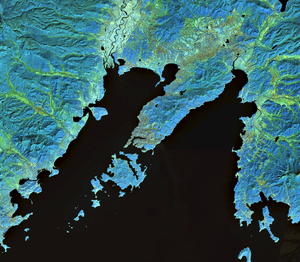Peter the Great Gulf

The Peter the Great Gulf (Russian: Залив Петра Великого) is the largest gulf of the Sea of Japan adjoining the coast of Russia's Primorski Krai. The Muravyov-Amursky Peninsula and a chain of outlying islands divides the gulf of about 6,000 km² into the Amur Bay and the Ussuri Bay. Vladivistok is located there.
Peter the Great Bay, Russian Zaliv Petra Velikogo, inlet, Sea of Japan, northwestern Pacific Ocean, in the Maritime (Primorye) region of far eastern Russia. The bay extends for 115 miles (185 km) from the mouth of the Tumen River (on the Russian-Chinese border) northeast across to Cape Povorotny. The bay reaches inland for 55 miles (88 km) and contains the port of Vladivostok, which is situated on the Muravyov-Amursky Peninsula between Amur and Ussuri bays. The town of Posyet is on Posyeta Bay (southwest). The functioning of these harbours is severely limited by the freezing of the bay from early December to mid-April. Formerly (from 1855) known as Victoria Bay, the inlet was renamed (1859) to honour Peter I the Great.
Peter the great was the founder of Saint Petersburg in 1703.
The coastline of about 1,500 kilometers is indented by many smaller bays, the chief of which are Possiet, to the west; the Zolotoy Rog (the "Golden Horn"), Diomede and Lazurnaya (the "Shamora", with its fine sandy beaches) on the Peninsula; and Strelok, Vostok and Nakhodka to the east. The islands include the Rimsky-Korsakov Archipelago and Furugelm Island to the west, the Eugénie Archipelago (of which Russky Island is the largest), separated from the Peninsula by the Eastern Bosphorus), and Askold and Putyatin to the east.
The Manza War in 1868 was the first attempt by Russia to expel Chinese from territory it controlled. Hostilities broke out around Peter the Great Gulf, in Vladivostok when the Russians tried to shut off gold mining operations and expel Chinese workers there.[1] The Chinese resisted a Russian attempt to take Askold Island and in response, 2 Russian military stations and 3 Russian towns were attacked by the Chinese, and the Russians failed to oust the Chinese.[2]
About 630 km² of the gulf area are protected as the Far Eastern Marine Nature Reserve. A sailing regatta that annually takes place in the gulf, is known as the Cup of the Peter the Great Gulf. In winter the northern bays are normally sealed by ice.
Between 5–12 July 2013, warships from the Russian Pacific Fleet and the North Sea Fleet of the People's Liberation Army Navy participated in Joint Sea 2013, which were bilateral naval maneuvers held in the Peter the Great Gulf. Joint Sea 2013 was the largest naval drill yet undertaken by the PRC's navy with a foreign navy.[3]
References
- ↑ Joana Breidenbach (2005). Pál Nyíri, Joana Breidenbach, ed. China inside out: contemporary Chinese nationalism and transnationalism (illustrated ed.). Central European University Press. p. 89. ISBN 9637326146. Retrieved 18 March 2012.
Probably the first clash between the Russians and Chinese occurred in 1868. It was called the Manza War, Manzovskaia voina. "Manzy" was the Russian name for the Chinese population in those years. In 1868, the local Russian government decided to close down goldfields near Vladivostok, in the Gulf of Peter the Great, where 1,000 Chinese were employed. The Chinese decided that they did not want to go back, and resisted. The first clash occurred when the Chinese were removed from Askold Island,
- ↑ Joana Breidenbach (2005). Pál Nyíri, Joana Breidenbach, ed. China inside out: contemporary Chinese nationalism and transnationalism (illustrated ed.). Central European University Press. p. 90. ISBN 9637326146. Retrieved 18 March 2012.
in the Gulf of Peter the Great. They organized themselves and raided three Russian villages and two military posts. For the first time, this attempt to drive the Chinese out was unsuccessful.
- ↑ "China, Russia to hold joint military drills". Xinhua. 2 July 2013. Retrieved 2 July 2013.; Minnie Chan (3 July 2013). "China to join Russia in joint naval drills in Sea of Japan". South China Morning Post. Retrieved 2 July 2013.; and "China to join Russia in Beijing’s largest-ever joint naval exercise with foreign partner". Associated Press. Washington Post. 2 July 2013. Retrieved 2 July 2013.
- (Russian) Detailed information about the Gulf